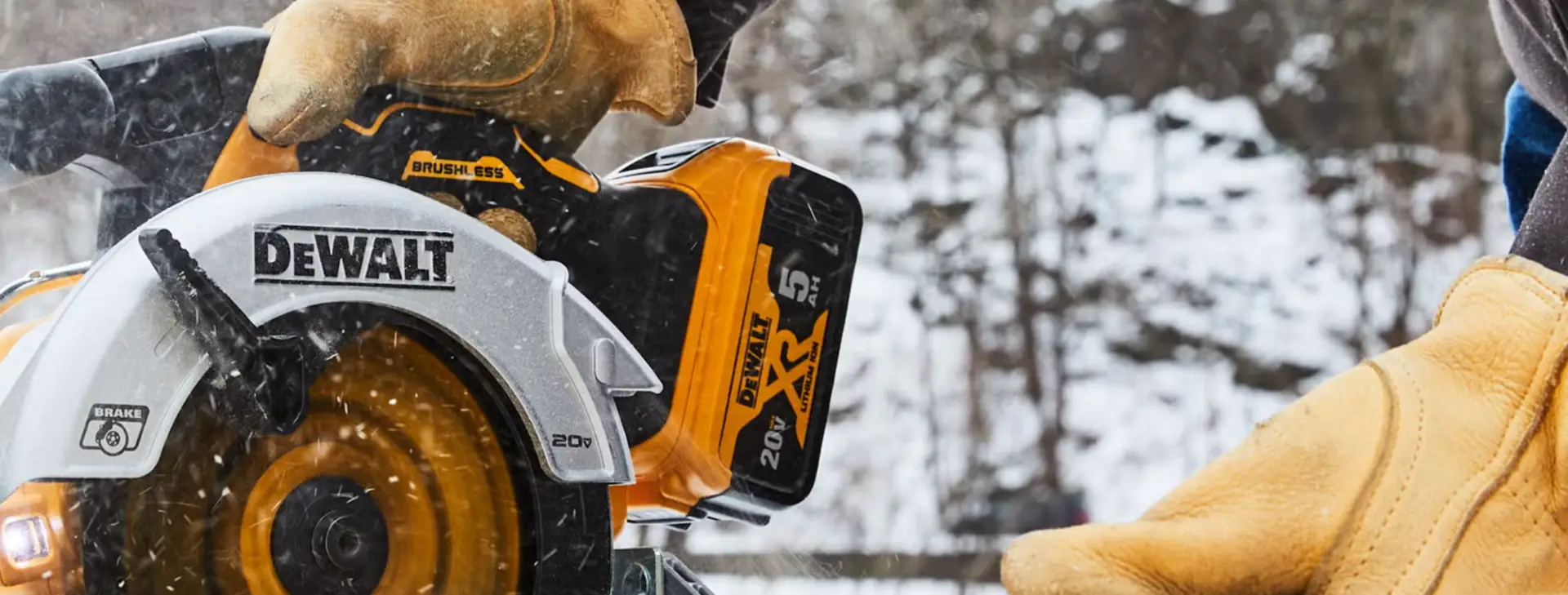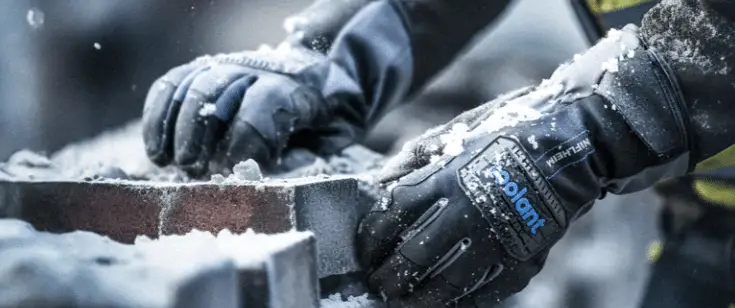Need to keep your hands warm and dry while working in winter? The right waterproof winter work gloves can make all the difference. In this article, we review the best options to help you stay comfortable and productive.
Key Takeaways
Waterproof winter work gloves are essential for keeping hands dry, warm, and productive in harsh conditions, with key features including waterproof membranes and various insulation materials.
Top-rated gloves, such as the Carhartt Waterproof Insulated Gloves, Mechanix Wear Coldwork Original, and Wells Lamont Hydrahyde Leather Hybrid, each offer unique benefits tailored to different user needs and environments.
To select the right waterproof winter work gloves, consider factors like insulation, fit, and activity level, as well as the importance of maintenance for longevity.
Key Features of Waterproof Winter Work Gloves

When it comes to winter work gloves, the features can make all the difference between a productive day and a miserable one. A critical component is the waterproof membrane, which prevents moisture from reaching the inner lining while allowing the outer shell to absorb some water. This keeps your hands dry, providing comfort and warmth.
Another important aspect is insulation. The top gloves use materials like:
Thinsulate
Neoprene
Wool
Silk
Down
Natural materials such as wool, silk, and down provide excellent warmth and comfort, making them ideal for extreme weather conditions.
These materials ensure warmth without excessive bulk. For instance, Thinsulate ranges from 80g to 200g, providing warmth while maintaining dexterity. Fleece or wool linings further enhance the warmth, making these gloves suitable for the harshest conditions.
These gloves also shield against wind, snow, and ice, essential for any outdoor work. Balancing warmth and dexterity is challenging, but the best gloves achieve this. Keeping hands dry and warm in harsh weather conditions is not just a matter of comfort but also of maintaining the ability to perform tasks efficiently.
Knowing these features helps in choosing gloves that provide warmth and allow you to work comfortably. The right pair of gloves will protect your hands from the elements, keeping them warm and dry, which in turn keeps you productive and safe.
Best Waterproof Winter Work Gloves Reviewed

Choosing the best gloves requires evaluating factors such as insulation, water resistance, and durability. Here, we review three top-rated gloves that have stood out in these aspects.
Each pair caters to different needs with unique features.
Carhartt Waterproof Insulated Gloves
The Carhartt Waterproof Insulated Gloves are a favorite among those who work in extreme cold. Designed for extreme cold, these gloves keep hands warm even at -20°F. Their superior insulation keeps your hands warm in harsh conditions.
Fully waterproof, these gloves stand out from many competitors. They completely block wind, enhancing cold-weather comfort. The snug yet comfortable fit protects your hands without compromising dexterity.
In addition to their superior insulation and waterproof capabilities, these gloves also include a leather palm for enhanced grip and durability. The combination of materials ensures that the gloves are not only warm but also durable and capable of handling tough tasks. For maximum warmth and protection, the Carhartt Waterproof Insulated Gloves are an excellent choice.
Mechanix Wear Coldwork Original
The Mechanix Wear Coldwork Original gloves are made from a combination of rubber, fleece, and softshell materials, providing a balance of flexibility and protection. These gloves’ touchscreen compatibility allows device use without removal, especially useful in cold weather. The roomy fit enhances comfort and maintains dexterity. However, compared to the Outdoor Research Flurry Sensor gloves, which offer superior warmth and touchscreen compatibility, the Mechanix Wear Coldwork Original gloves may fall short in extremely cold conditions.
However, they are not the warmest available. Their minimal insulation makes them less suitable for extremely cold temperatures. Additionally, they are prone to soaking moisture quickly, which can impact their water resistance and overall performance in wet conditions.
Despite these limitations, they are a good option for flexibility and touchscreen use in milder conditions. They provide comfortable fit and decent protection, suitable for various tasks.
Wells Lamont Hydrahyde Leather Hybrid
The Wells Lamont Hydrahyde Leather Hybrid gloves are made from a combination of leather, spandex, and neoprene, providing a good balance of durability and flexibility. With a weather resistance rating of 5.0, they handle wet conditions effectively. High comfort and dexterity ratings make them suitable for detailed tasks.
Though thicker and less flexible than some competitors, they perform well in various tests. The leather palm improves grip and durability, making them reliable for tough tasks. The material blend ensures warmth and waterproofing, making them versatile for winter work.
Overall, they offer a good mix of comfort, durability, and weather resistance. They are a solid choice for reliable protection in various winter conditions.
Testing Methods for Waterproof Winter Work Gloves

Rigorous testing methods ensure winter work gloves meet necessary standards. These tests evaluate water resistance, warmth, insulation, dexterity, and comfort. Gloves are tested in daily activities, cold temperatures, and wet conditions to evaluate overall performance. Long-term durability and construction are assessed along with initial testing.
Gloves are evaluated based on dexterity, warmth, waterproof capability, wind resistance, breathability, dry time, and special features. Seven out of eight pairs met the testing criteria, highlighting thorough evaluation.
Testing in temperatures around the mid-30s offered a realistic view of cold-weather performance. Testing activities included late fall projects and daily dog walks to simulate varied use cases.
Water Resistance Test
Water resistance is vital for keeping hands dry in harsh conditions. In tests, gloves were submerged for five minutes to assess impermeability. A specific test involved dunking gloves in water for two minutes.
The Carhartt Waterproof Insulated Gloves proved to be truly waterproof.
Warmth and Insulation Test for Maximum Warmth
Warmth and insulation tests were conducted in frigid temperatures from -30°F to around 32°F. Gloves were evaluated for warmth at these extremes to ensure suitability for diverse winter conditions.
Testing included activities like gripping, lifting, and prolonged wear to assess real-world performance. Walking and working in snow and ice were included to ensure adequate insulation and movement.
Dexterity and Comfort Test
Dexterity and comfort were tested during practical tasks to assess fit and flexibility. Mechanix gloves scored 10 out of 10 for dexterity, showing excellent flexibility and maneuverability.
Testing dexterity and comfort ensures gloves fit the fit and flexibility needed for detailed tasks.
How to Choose the Right Waterproof Winter Work Gloves

Selecting the right gloves involves considering several factors. Personal metabolism, activity level, and environmental conditions influence how warm a glove feels. Waterproof gloves maintain warmth by preventing moisture, which can cause cold hands.
Using waterproofing waxes like Nikwax enhances water resistance of leather gloves while maintaining breathability. Focus on seams when applying wax, let it sit, then wipe off excess with a damp cloth.
Evaluating Your Needs
Job types and activity levels affect warmth needs; more active individuals need gloves with adequate ventilation. Assessing specific needs ensures gloves match the user’s requirements.
Different jobs require specific features; for example, outdoor labor needs enhanced insulation and durability. Frequency of use and local weather conditions determine the needed insulation and waterproofing level.
Activity and Purpose
When choosing the best winter work gloves, it’s essential to consider the activity and purpose for which they will be used. Different activities require different features and functionalities in a glove. For example, if you’ll be working outdoors in cold and wet conditions, you’ll need gloves that are waterproof and insulated to keep your hands warm and dry. On the other hand, if you’ll be working with tools or machinery, you’ll need gloves that provide dexterity and grip to prevent accidents.
Some common activities that require winter work gloves include:
Outdoor construction or landscaping work
Snow removal or plowing
Ice fishing or other winter sports
Stacking wood or performing other outdoor chores
Working with tools or machinery in cold conditions
When choosing gloves for these activities, consider the following factors:
Insulation: Look for gloves with thick, warm insulation to keep your hands warm in cold conditions.
Waterproofing: Choose gloves with a waterproof liner to keep your hands dry in wet conditions.
Dexterity: Select gloves that provide a good grip and dexterity to prevent accidents when working with tools or machinery.
Durability: Opt for gloves made with durable materials that can withstand rough handling and harsh weather conditions.
By matching the gloves to the specific activity, you ensure that your hands remain warm, dry, and protected, allowing you to work efficiently and safely in various cold conditions.
Importance of Proper Fit
A snug fit is essential for maintaining warmth and keeping cold air out. Proper fit ensures no cold air infiltrates, keeping hands warm. Gloves should have clear sizing information, and features like adjustable cuffs or straps can ensure a snug fit.
Consider finger length and proper fit when choosing touchscreen-compatible gloves. Measuring the length of the middle finger is crucial to achieve an optimal fit for improved dexterity and comfort.
Key Features to Look For
Touchscreen compatibility allows device operation without removing gloves. Adjustable safety cuff improve fit and insulation, retaining warmth and keeping cold air out.
Quality gloves are designed with thermal insulation to maintain hand warmth in cold conditions, making them some of the warmest gloves available.
Material and Construction
The material and construction of winter work gloves are critical factors to consider when choosing the best pair for your needs. Different materials offer different benefits, and the construction of the glove can affect its performance and durability.
Some common materials used in winter work gloves include:
Leather: Leather gloves are durable and provide a good grip, but they can be heavy and stiff. They are ideal for tasks that require a strong, reliable material.
Synthetic materials: Synthetic materials such as nylon or polyester are lightweight and breathable, but they may not be as durable as leather. These materials are often used in gloves that require flexibility and comfort.
Insulating materials: Materials such as Thinsulate or Polarguard provide warmth and insulation, but they may not be as breathable as other materials. These are essential for keeping hands warm in frigid temperatures.
When it comes to construction, consider the following factors:
Stitching: Look for gloves with strong, durable stitching that can withstand rough handling.
Seams: Choose gloves with seams that are sealed or taped to prevent water from entering the glove.
Liner: Opt for gloves with a waterproof liner to keep your hands dry in wet conditions.
Cuff: Select gloves with a safety cuff to prevent snow or debris from entering the glove.
By understanding the materials and construction of winter work gloves, you can choose a pair that offers the right balance of warmth, durability, and comfort for your specific needs.
Benefits of Waterproof Winter Work Gloves

These gloves prevent hands from getting wet and cold, ensuring efficiency. They create a safer work environment by reducing the risk of frostbite and cold-related injuries. Leather work gloves provide additional protection in these conditions.
Warm hands enhance focus and dexterity, boosting work performance and productivity. Comfortable gloves boost morale, contributing to a motivated and satisfied workforce.
Performance in Various Conditions
Winter work gloves are designed to perform well in a variety of conditions, from cold and wet to snowy and icy. When choosing the best pair for your needs, consider the following factors:
Cold weather: Look for gloves with thick, warm insulation to keep your hands warm in cold conditions.
Wet conditions: Choose gloves with a waterproof liner to keep your hands dry in wet conditions.
Snowy conditions: Opt for gloves with a good grip and traction to prevent slipping on snowy surfaces.
Icy conditions: Select gloves with a safety cuff to prevent ice or snow from entering the glove.
Some common features that can enhance the performance of winter work gloves in various conditions include:
Waterproofing: A waterproof liner can keep your hands dry in wet conditions.
Insulation: Thick, warm insulation can keep your hands warm in cold conditions.
Grip: A good grip can prevent slipping on snowy or icy surfaces.
Traction: Traction on the palm or fingers can provide additional grip and stability.
When testing winter work gloves, consider the following methods:
Cold weather testing: Test the gloves in cold conditions to see how well they keep your hands warm.
Wet weather testing: Test the gloves in wet conditions to see how well they keep your hands dry.
Snowy weather testing: Test the gloves in snowy conditions to see how well they provide traction and grip.
Icy weather testing: Test the gloves in icy conditions to see how well they prevent ice or snow from entering the glove.
By evaluating the performance of winter work gloves in various conditions, you can ensure that you choose a pair that will keep your hands warm, dry, and protected, no matter what the weather throws at you.
Maintenance Tips for Longevity
Clean gloves with a damp cloth instead of machine washing to avoid material damage. Air dry instead of wringing out to prevent damage and maintain shape.
With proper care, high-quality leather gloves can last 8 to 10 years.
Summary
Summarize the key points discussed in the blog post. Emphasize the importance of choosing the right waterproof winter work gloves for safety, comfort, and productivity. End with an inspiring note on the benefits of investing in high-quality gloves and the positive impact they can have on your work experience in cold weather.
Frequently Asked Questions
What are the key features to look for in waterproof winter work gloves?
When selecting waterproof winter work gloves, prioritize a waterproof membrane, effective insulation, a snug fit, and durable materials for optimal performance and protection.
How can I test the water resistance of my gloves?
To test the water resistance of your gloves, submerge them in water for a few minutes and check for any moisture that seeps through. This simple method will help you gauge their effectiveness.
Why is a snug fit important for winter gloves?
A snug fit is crucial for winter gloves as it helps retain warmth and prevents cold air from seeping in, ensuring your hands stay warm and comfortable in frigid conditions.
How often should I apply waterproofing wax to leather gloves?
You should apply waterproofing wax to your leather gloves once or twice a season, paying special attention to the seams for optimal protection.
Can I machine wash my waterproof winter work gloves?
You should clean your waterproof winter work gloves with a damp cloth instead of machine washing them to avoid damaging the material. Air drying will help maintain their shape.


